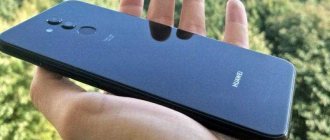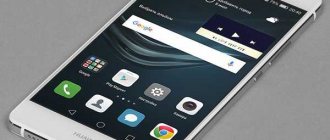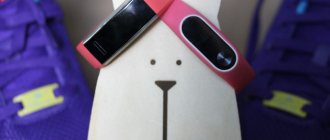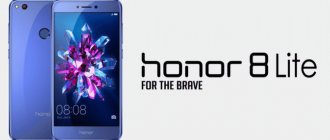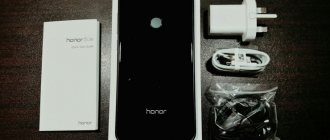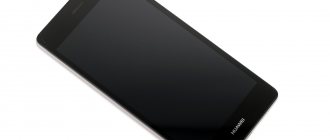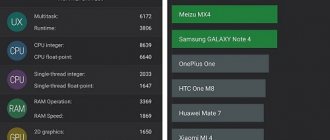Most 2021 flagships feature frameless designs, 18:9 aspect ratio screens, and dual cameras. Naturally, manufacturers have already begun to equip mid-segment models with similar functions. More and more smartphones with dual main cameras are appearing, there are even a couple of models with elongated screens, but until today no one has combined all these features in one device. It's time to get acquainted with Huawei Mate 10 Lite - a lightweight version of the flagship Mate 10 Pro, with dual main and front cameras and a large screen.
LineHUAWEI Mate 10 Lite Smartphones and mobile phones on
Models in the line: 1
Price range: 4,440 − 4,464 UAH
In some markets, the Mate 10 Lite is presented under the name Nova 2i for a reason. The body lines and brushed metal are reminiscent of the Nova 2, although the form factor is similar to the Mate 10 Pro, and the main camera unit is similar to last year’s Mate 9. As a result, the choice of name for Ukraine can be explained rather by the start of sales of the current generation of “adults” Mate. The company should be comfortable positioning the more affordable model as a lighter version of the Mate 10 Pro, although it could also be seen as an extension of the Nova lineup.
Review of the Huawei Mate 10 Lite smartphone and its characteristics
2017 set the trend for frameless design, dual cameras, and an 18:9 aspect ratio. These features are typical primarily for flagships from well-known brands, but towards the end of the year they were already widely used in the budget and mid-price segments. Now almost every new smartphone boasts a dual camera, but all these technologies together are still not that common. A review of Huawei Mate 10 Lite showed that it is positioned as a simplified version of the company’s main flagship, which received a large display, dual main and front cameras.
Specifications:
- SIZE: 72.5x156.2x7.5 mm;
- WEIGHT: 164 g;
- INTERNAL MEMORY: 64 GB, expandable - microSD up to 256 GB;
- RAM: 4 GB;
- DISPLAY: 5.88 inches, IPS LCD capacitive, 16 million colors, 1440×2560 pixels;
- PROCESSOR: Hisilicon Kirin 970
- Octa-core (4×2.4 GHz Cortex-A73 & 4×1.8 GHz Cortex-A53);
- CAMERA: Dual 20 MP +12 MP, f/1.6, OIS, 2x lossless zoom, Leica optics, phase detection & laser autofocus, dual-LED (dual tone) flash;
- VIDEO: [email protected] , [email protected] /60fps;
- BATTERY: Li-Po 4000 mAh;
Design of Huawei Mate 10 Lite
Premium materials were used to assemble the case: metal side frame and back. There are also the usual plastic inserts that improve the quality of communication reception. The front panel is covered with protective glass made with a 2.5D effect. The frames around the perimeter of the display are small, but they are there, so the hero of our review cannot be called frameless.
Traditionally, there are no functional elements under the display; only the manufacturer’s logo is displayed.
On top there is the usual set of sensors, a conversational speaker, an LED event indicator and a front camera represented by a dual module. Already out of the box, a film is glued to the display, which provides it with reliable protection from scratches. But in order for the phone to survive a fall, it is better to glue the glass.
When purchasing, you will have a choice of a black or blue case. All edges are rounded, which ensures a comfortable hand grip and the absence of any discomfort during use. All functional elements are located in the usual place; in this regard, the manufacturer has developed a convenient formula and continues to follow it in each of its smartphones.
The Huawei Mate 10 Lite review shows that there is a volume rocker on the right, as well as a power key.
The left side is occupied by a hybrid slot. Once again we are faced with a choice - a second SIM card or microSD, which not everyone will appreciate.
Only an additional microphone was placed on the top panel, effectively suppressing noise during a conversation or video recording.
At the bottom there is an external speaker, a microphone, and a 3.5 mm audio jack, for which we can say a special thank you. But the use of the microUSB port was a complete disappointment - the format is already seriously outdated, but the manufacturer still installs USB-C exclusively in its flagship devices. The same applies to the NFC chip and dual-band Wi-Fi. I would like to believe that the situation will change soon.
The backdrop is made of metal and looks especially beautiful in the blue version. Two horizontal plastic inserts hide the antennas underneath. On top is the main dual camera, which does not protrude much, but still protrudes beyond the body. A flash is installed above it, and a fingerprint scanner is provided just below. It can be used not only to restrict access to a smartphone, but also to control gestures. So, swiping from top to bottom opens the notification curtain. There are additional options that can be found in the settings.
The review of the Huawei Mate 10 Lite smartphone showed that the device turned out to be easy to use and visually attractive. Its ergonomics benefit from its small thickness and rounded edges. The 5.9-inch device fits well in the hand, although of course you won’t be able to reach the top point with one hand. The build quality is at the highest level; you wouldn’t expect anything else from Huawei. The only questionable solution is the protruding camera, which makes it possible to accidentally damage it when the smartphone is lying on its back. The solution may be film, which can be ordered for almost nothing on Aliexpress.
Detailed technical specifications
Make and model
Make and model of the device, and alternative names (if any).
| Brand Device manufacturer company. | Huawei |
| Model Device name. | Mate 10 Lite |
| Alternative names Other model names, if available. Sometimes the model is called differently, depending on the country or because of popular nicknames. | RNE-L01 RNE-L02 RNE-L03 RNE-L21 RNE-L22 RNE-L23 |
Design
Appearance of the device including dimensions, weight, volume, colors and materials.
| Width The horizontal side of the device when used in standard orientation. | 75.2 mm (millimeters) |
| Height The vertical side of the device when used in standard orientation. | 156.2 mm (millimeters) |
| Thickness The cross-sectional size of the device. | 7.5 mm (millimeters) |
| Weight How much does the device weigh excluding the case, SIM and memory cards and other additional elements. | 164 g (grams) |
| Volume Approximate value calculated using the formula: length times width times height. | 88.1 cm³ (cubic centimeters) |
| Colors What colors is the device available in? | Black Blue |
| Housing materials What materials is the body made of? | Aluminium alloy |
System on a Chip (SoC)
A system on a chip, a single-chip system (System on a Chip, SoC) is when several systems performing different device functions are connected on one chip.
| System on a Chip (SoC) A single-chip system that contains components such as a processor, graphics accelerator, memory units, communication interfaces, etc., as well as software for the operation of the system. | Huawei HiSilicon KIRIN 659 |
Central processing unit (CPU)
| Central processing unit (CPU) The main component of the device is responsible for calculations and data processing. | 4x 2.36 GHz ARM Cortex-A53, 4x 1.7 GHz ARM Cortex-A53 |
| Technical process What technological process is used to make the chip? The smaller the process technology, the better - the chips consume less power and generate less heat. | 16 nm (nanometers) |
| Processor size Processor capacity is a parameter that indicates how many bits of data a processor register processes in 1 clock cycle. This is usually 32 or 64 bits. | 64 bit |
| Instruction Set Architecture Instruction set architecture (ISA) is a programmable part of the microprocessor core used by software to control the operation of the processor. | ARMv8 |
| Number of processor cores The processor can be either single-core or multi-core. The performance of the processor depends on the number of cores (threads). The more cores working simultaneously, the higher the power consumption, so in mobile devices all cores are used only under high load. | 8 |
| CPU clock speed Clock speed is the number of operations per second that a processor or its core can achieve. The higher the frequency, the higher the overall performance of the device, but performance also depends on the processor architecture and the number of cores. | 2360 MHz (megahertz) |
Graphics Processing Unit (GPU)
| Graphics Processing Unit (GPU) The graphics processing unit (GPU) is used to process and display graphics - 3D effects, games, interfaces and other visual elements. Due to the pipeline architecture, the GPU is many times more efficient in graphics processing than the processor. | ARM Mali-T830 MP2 |
| Number of GPU cores Similar to a processor, a GPU can have one core or several. The number of cores (threads) determines the performance and amount of information processed. The more cores, the better. | 2 |
Random access memory (RAM)
| Amount of random access memory (RAM) RAM (Random Access Memory, RAM, RAM) is temporary memory (works only while the device is running), which stores data and code for the operational operation of programs and applications. The more RAM, the more programs you can run simultaneously without loss of performance (there will be fewer “brakes”). | 4 GB (gigabytes) |
| Type of random access memory (RAM) Information about the type of RAM used by the device. | LPDDR3 |
| Number of RAM channels 1 is a single-channel RAM operating mode, basic, when 1 memory module is used. 2 is already a two-channel mode - a mode of parallel operation of 2 modules or pairs of modules, memory channels - this mode is 2 times faster than a single-channel one. 3 – three-channel mode is 3 times faster than single-channel mode. | Dual channel |
| RAM frequency The frequency of RAM determines the speed of RAM, or rather the speed of data transfer and reception. In theory, the higher the frequency, the more powerful the RAM. | 933 MHz (megahertz) —- GPU Turbo |
Built-in memory
Most mobile devices have built-in Flash memory, which is used as a storage for system data, the operating system, as well as user data - photos, videos, recordings and much more.
| Built-in memory capacity The higher the amount of built-in memory, the more games, programs, music, videos and your other files will fit in the device, especially the amount of memory is important when the device does not support memory cards. | 64 GB (gigabytes) |
Operating system
A mobile operating system (OS) is pre-installed software with a well-thought-out interface for user control of device functions.
| Operating system (OS) The operating system installed by default by the device manufacturer, as well as its version. | Android 7.0 Nougat Android 8.0 Oreo |
| User interface User interface (UI - user interface) is usually a graphical shell that ensures the transfer of information between the user and the operating system. | EMUI 5.1 EMUI 8.0 |
Battery
To operate autonomously, a mobile device requires a battery that powers all its components.
| Battery capacity The main characteristic of a battery is its maximum capacity, that is, the charge it can store. Capacity is measured in mAh (mAh, milliamp-hour). The higher the capacity, the longer the mobile device can work. | 3340 mAh (milliamp-hours) |
| Battery type Many types of batteries have been used in portable devices, but NiCd (nickel-cadmium), NiMH (nickel-metal hydride), and even more so SLA (lead-acid) batteries are already considered obsolete. Instead, modern mobile devices use Li-Ion (lithium-ion) and Li-Pol, Li-Poly (lithium-polymer) batteries. | Li-polymer |
| Power adapter Characteristics of the charger (adapter, power supply) included in the standard package of the mobile device. More precisely, the output voltage in volts (V) and the output current in amperes (A). | 5 V (volts) / 1 A (amps) |
| Call duration on 2G network (GSM, CDMA) Approximately how long will it take for a fully charged battery to discharge when talking in 2G mode. Approximate, because this time is influenced by many factors, such as the operator, signal strength, active applications, and so on. | 20 h (hours) 1200 min (minutes) 0.8 days |
| Waiting time on 2G network (GSM, CDMA) Approximately how long will it take for a fully charged battery to discharge if the mobile device is not used and is connected in 2G mode. | 550 h (hours) 33000 min (minutes) 22.9 days |
| Call duration on 3G network (WCDMA, UMTS, CDMA2000) About how long a fully charged battery will be discharged during a call on third generation networks. Approximate time because it is influenced by various factors, including ambient temperature. | 20 h (hours) 1200 min (minutes) 0.8 days |
| Waiting time on 3G network (WCDMA, UMTS, CDMA2000) About how long a fully charged battery will be discharged if the mobile device is in standby mode and connected to third generation networks. | 550 h (hours) 33000 min (minutes) 22.9 days |
Screen
The screen (display) is the main element for displaying graphic information.
| Technology The technology used to make the screen. There are many types of display manufacturing with their pros and cons. | IPS |
| Diagonal The screen diagonal of a device is measured in inches (inch, in or simply ″), and 1″ is equal to 2.54 cm. | 5.9 in (inches) 149.86 mm (millimeters) 14.99 cm (centimeters) |
| Width Approximate screen width | 67.02 mm (millimeters) 6.7 cm (centimeters) |
| Height Approximate screen height | 134.04 mm (millimeters) 13.4 cm (centimeters) |
| Aspect Ratio Aspect ratio is the ratio of the shorter side of the screen, which is considered to be 1, to the longer side, which is denoted by a decimal fraction indicating the ratio to the short side. | 2:1 2:1 (18:9) |
| Screen resolution Screen resolution is the number of horizontal pixels (dots) multiplied by the number of vertical pixels. The higher the resolution, the more detailed the image will be. | 1080 x 2160 pixels |
| Pixel Density The number of pixels per inch or PPI (pixels per inch) indicates the density of pixels per 1 inch (2.54 cm) of the screen. The higher the PPI, the sharper the image, and the less visible or even invisible “squares and dots” (pixels). | 409 ppi (pixels per inch) 160 ppcm (pixels per centimeter) |
| Color depth Color depth means how many bits are used in 1 pixel to display color (bits per pixel). | 24 bit 16777216 colors |
| Screen area Approximate usable area occupied by the screen on the front of the device. The higher the percentage, the narrower the frames around the display or the smaller the “chin with bangs.” | 76.72% (percentage) |
| Touch screen A touch screen is a device that usually covers the display and is a touch input tool. In fact, in mobile devices, the touchscreen is a replacement for the keyboard and mouse. | Yes |
| Touch screen type There are many types of touch screens, with their pros and cons. Mobile devices often use capacitive touchscreens, but technology does not stand still and new types of sensors are appearing. | Capacitive |
| Multi-touch Touch screen support for two or more touches. For example, zooming photos with two fingers. | Yes |
| 2.5D screen 2.5D is a display with rounded edges. Device manufacturers use a 2.5D screen as a design element, for a pleasant tactile sensation, or to add durability, dust and moisture protection. | Yes |
Main camera
The main camera, usually built into the rear of the device, is designed for creating photo and video content.
| Maximum image resolution This is the maximum number of pixels (dots) horizontally and vertically. The higher the resolution, the more detailed the image will be. Resolution can also be indicated in megapixels - this is the total number of pixels that can be in the image, calculated by the formula: vertical pixels multiplied by the number of horizontal pixels and divide the resulting amount by 1 million. | 4608 x 3456 pixels 15.93 MP (megapixels) |
| Matrix type There are two main types of photomatrix, CCD (Charge-Coupled Device) and CMOS (Complimentary Metal-Oxide Semiconductor). Mobile devices mainly use a CMOS matrix - it requires less space, has low power consumption and heating. Recently, new types of sensors have begun to appear, for example PureCel from OmniVision. | CMOS BSI (backside illumination) |
| Focal length Focal length is the distance from the center of the lens to the image sensor. | 3.81 mm (millimeters) |
| Diaphragm Aperture (f-number, f) is used to control the light flux passing through the lens. The aperture is indicated by a fraction, and the smaller the fractional number, the higher the aperture passing through the lens. The more light that passes through the lens, the better overall, less noise in your photos and better night photography. | f/2.2 |
| Flash type Most mobile devices are equipped with light-emitting diode (LED) flashes, but there are also xenon flashes. As a flash, xenon is better - it is more powerful, but LED is more versatile (can work as a flashlight) and consumes less electricity. | LED |
| Maximum video resolution This is the maximum number of pixels (dots) horizontally and vertically. The higher the resolution, the more detailed the image will be. | 1920 x 1080 pixels 2.07 MP (megapixels) |
| FPS video recording at maximum resolution FPS (Frames per Second, frame rate) is the number of frames that changes in 1 second. The higher the number of frames per second, the smoother the image will be. In this case, we mean the number of frames that the camera can achieve at its maximum resolution; the lower the resolution, the higher the FPS can be. | 30 fps (frames per second) |
| Presence of flash Incorporating a flash into a mobile device allows you to take pictures in low light conditions. Creates the necessary lighting and compensates for the lack of natural light. | Yes |
| Digital zoom With digital zoom (zoom, enlargement), the subject is brought closer due to software image algorithms. The higher the magnification with digital zoom, the worse the image quality (noise, blur) will be compared to a non-zoomed one. | Yes |
| Focus on face Function of auto-detection of living objects and autofocus on their face or head. | Yes |
| Panoramic shooting mode Panoramic photography is a series of frames where each subsequent frame is a continuation of the previous one; at the end of the shooting, all frames are stitched together at the software level to create a panoramic photograph. Frames can be shot both vertically and horizontally, and their width can be up to 360 degrees. This type of shooting is used when the camera's viewing angle is not enough to capture the entire scene. | Yes |
| HDR shooting mode HDR photography takes a quick series of shots with highlights, midtones, and shadows, then combines them into a single frame with high dynamic range. | Yes |
| White balance White balance is a setting that helps ensure the correct color reproduction in an image by determining the color temperature of the light source in the frame. The balance can be set either automatically or manually. | Yes |
| ISO Setting ISO is the level of light sensitivity. The lower the ISO, the less sensitive the camera's light sensor and the smoother the image with less noise. The higher the ISO, the higher the light sensitivity, but more noise, graininess, or decreased sharpness. | Yes |
| Additional Information Additional information about the functions and characteristics of cameras. | Autofocus Continuous shooting Geo-tagging Touch focus Exposure compensation Self-timer Scene select mode |
Additional cameras
Secondary cameras allow you to expand the capabilities of the main camera, such as adding a wide shooting angle, sharpness, optical zoom and other functions depending on the type of secondary camera.
| Second additional camera | 2 MP (megapixels) |
Front-camera
The front camera of a mobile device (selfie camera, rear camera) is a camera on the front part, which is usually used for video communication, recognition of gestures or faces, and selfie photographs.
| Photo resolution The maximum image resolution that the camera can produce. As resolution increases, image detail increases. Resolution can also be indicated in megapixels (the total number of pixels that an image can consist of) - these are vertical pixels multiplied by horizontal pixels and divided by 1 million. | 4160 x 3120 pixels 12.98 MP (megapixels) |
| Matrix type There are not many types of matrices, the main ones are CCD, PureCel and the most popular in mobile devices due to low power consumption and compact size - CMOS. | CMOS BSI (backside illumination) |
| Diaphragm An aperture (or aperture) is essentially an adjustable baffle to control the amount of light passing through the lens. The aperture is indicated by a fraction, and the smaller it is, the more light passes through the lens, which has a positive effect on photographs - there will be less noise and better night photography. While the main cameras also come with an adjustable aperture, most front cameras have a fixed aperture. | f/2 |
| Video resolution This is the maximum resolution the camera can record video at. The higher the resolution, the better. | 1280 x 720 pixels 0.92 MP (megapixels) |
| Frame rate (FPS) of video shooting This is talking about FPS at maximum video resolution; at lower resolutions, the frame rate per second can be higher. FPS determines the smoothness of the video, as well as the ability to speed up or slow down it. | 30 fps (frames per second) — Focal length (35 mm equivalent) — 26 mm Secondary front camera — 2 MP Pixel size — 1.75 μm (#2) |
| Camera focal length Focal length is the distance from the center of the lens to the sensor. The focal length determines the viewing angle, scale and degree of blur. | 3.5 mm (millimeters) |
SIM card
Subscriber Identification Module (SIM) used in mobile devices to identify subscribers in cellular networks.
| Type, size of SIM card A regular (mini SIM) card has dimensions of 25x15 mm. Micro SIM - 15x12 mm. Nano SIM - 12.3x8.8 mm. The sizes of SIM cards are different and not interchangeable. There is also an eSIM (virtual, electronic SIM card), it is built into the device and does not take up space. | Nano-SIM (4FF - fourth form factor, since 2012, 12.30 x 8.80 x 0.67 mm) Nano-SIM / microSD |
| Number of SIM cards How many SIM cards does the device support? | 2 |
Mobile networks
This is a system in which communication and data transfer is carried out between subscribers, the location of one or more of which changes. This section lists the supported mobile communication standards and frequencies.
| GSM GSM (Global System for Mobile Communications) is a standard for digital mobile cellular communications of the second generation 2G with time and frequency division of channels. GSM came to replace analog cellular communications 1G (first generation). | GSM 850 MHz GSM 900 MHz GSM 1800 MHz GSM 1900 MHz |
| UMTS UMTS (Universal Mobile Telecommunications System), also called 3GSM, is a third generation (3G) mobile communications standard based on the WCDMA air interface. | UMTS 850 MHz UMTS 900 MHz UMTS 2100 MHz |
| LTE LTE (Long-Term Evolution, often referred to as 4G LTE) is a standard for wireless high-speed data transmission, which, although it belongs to fourth generation networks (4G), is essentially a transitional stage from 3G to 4G, greatly accelerating data transfer speeds. The standard has an improved version, LTE Advanced (LTE-A), which can already be considered a full-fledged 4th generation network. | LTE 800 MHz LTE 900 MHz LTE 1800 MHz LTE 2100 MHz LTE 2600 MHz |
Mobile network data standards
What data transfer standards in cellular networks are supported by the device, as well as their speed.
| Data transmission technologies Technologies for receiving and transmitting data, as well as their maximum speed. | UMTS (384 kbit/s) EDGE GPRS HSPA+ (HSUPA 5.76 Mbit/s, HSDPA 42 Mbit/s) LTE Cat 6 (51.0 Mbit/s, 301.5 Mbit/s) |
WiFi
Wi-Fi (Wireless Fidelity) is a technology for wireless data transmission over a local network among devices based on IEEE 802.11 standards.
| Wi-Fi Direct support The Wi-Fi Direct protocol allows multiple devices to connect directly, bypassing the use of routers or access points. | Yes |
| Wi-Fi Hot-Spot A hotspot is a Wi-Fi access point. In a mobile device, Hot-Spot turns the smartphone into a Wi-Fi access point, essentially turning it into a router capable of distributing the Internet. | Yes |
| WiFi Supported WIFI wireless network standards. | 802.11b (IEEE 802.11b-1999) 802.11g (IEEE 802.11g-2003) 802.11n (IEEE 802.11n-2009) |
Bluetooth
Bluetooth (BT, bluetooth (z), “blue tooth”) is a short-range wireless network (up to 10, sometimes 100 meters) operating on radio waves to transmit voice and data between devices.
| Bluetooth version Bluetooth technology is actively developing and, since 1998, has been constantly updating versions of the standard. Each subsequent version introduces one or several improvements in data exchange speed, range, facilitates pairing, reduces power consumption, or introduces some new protocols and operating profiles. The higher the Bluetooth version, the better. The technology is also backward compatible, for example, if your mobile device has version 5.0, then it will work with accessories version 4.2 and lower, but the improvements introduced in version 5.0 will not work; they will work only if both the device and accessories are version 5. | 4.2 |
| Bluetooth Low Energy (BLE) Bluetooth LE is a low energy BT protocol specification. | Yes |
| A2DP profile The A2DP Bluetooth profile is designed to transmit a high-quality two-channel stereo signal via Bluetooth to wireless headphones, speakers and other acoustics. | Yes |
Sensors
Modern devices have many sensors that help in measurements, trigger functions, and make using the device more pleasant.
| Light sensor The light sensor reacts to the light level and is able to adjust the screen brightness automatically based on this. This is necessary to reduce power consumption and ease of use of the device. | Yes |
| Proximity sensor The proximity sensor reacts to the proximity of the mobile device to some object. For example, the sensor is used when talking on the phone to turn off the screen, which saves energy and prevents you from pressing buttons with your ear or cheek. | Yes |
| Accelerometer An accelerometer is a sensor that measures apparent acceleration, that is, it determines the position and distance at which a mobile device moves in space. Based on the data from this sensor, the screen orientation change, pedometer, control using tilts and gestures in games and applications, etc. work. | Yes |
| Fingerprint's scanner The scanner is responsible for authorization using a previously saved fingerprint, as a result of which the device is unlocked, payment is made, some action is confirmed - just put your finger on the scanner. Scanners can be either built into the body or built into a button or screen. | Yes |
| Digital compass This is software that displays data from a magnetic sensor or GPS in the form of a compass on the screen of a mobile device. If there are no sensors or GPS, then the digital compass will not work. | Yes |
| Additional sensors |
Audio
Audio - characteristics and capabilities of a mobile device in terms of sound.
| Music speaker There are two types of speakers in mobile devices - auditory and musical. The auditory speaker (speaker) is used for conversation, the music speaker (buzzer) is used to play music and sounds. | Speaker |
Radio
The radio in a mobile device can be built-in by the manufacturer (catch local radio channels, no internet required, often works only with headphones (as an antenna), but not always) or installed as an online application (requires internet, but more channels and often better quality) .
| Built-in radio Is a radio tuner integrated into the mobile device? | Yes |
Navigation and location
The location is determined by satellite navigation systems that track the device's autonomous geospatial location at multiple points. The most common satellite navigation systems are GPS, GLONASS, and the Chinese BeiDou.
| GPS GPS (Global Positioning System) is a global satellite navigation system that can determine the position of a mobile device, build routes and find the desired object on the map with an accuracy of several meters. | Yes |
| A-GPS A-GPS (Assisted GPS) is an assistive technology that will help you quickly find the location of your cellular device without waiting for satellite data, which is especially important in indoors and cities. Location is determined in various ways, for example, Wi-Fi access points, mobile towers, bluetooth and others. | Yes |
| GLONASS GLONASS is a Russian Global Navigation Satellite System, which is similar to GPS and works in tandem with it, increasing the accuracy and speed of navigation. | Yes |
| Additional navigation systems | BeiDou |
USB connector
USB (Universal Serial Bus) is a serial interface for connecting peripherals to computers, smartphones, laptops and much more. The interface allows you to exchange data and power a peripheral device with energy, as well as connect several peripheral devices to one USB connector at once.
| Connector type What type of USB connector is used in the device. | Micro USB |
| USB standard The higher the standard, the faster the throughput, or more precisely the data exchange rate. With version 3.0 of the standard, the current was increased to 0.9A, eliminating the need for additional power for some devices. | 2.0 |
| USB Mass Storage Connecting a mobile device via USB as a data storage device. That is, when you enable this mode, your device can be used as a flash drive. | Yes |
| Additional characteristics Additional features of the USB connector, for example, OTG, whether the connection is supported, peripheral devices and additional memory. | Charging via USB |
Headphone jack
A TRS headphone jack (or jack) is a common standard of connectors used for transmitting audio signals. By diameter there are jack (6.5 mm), mini-jack (3.5 mm) and micro-jack (2.5 mm). In mobile devices, the 3.5mm jack was considered the most popular and widespread, but recently they began to be removed, leaving only USB connectors, through which headphones are connected with a corresponding plug or using adapters.
| 3.5mm headphone jack Does the device have a 3.5 mm audio jack? | Yes |
Connection and synchronization
Options for synchronizing your mobile device and connecting it to other devices.
| Connection, synchronization Types of synchronization and connection technologies supported by the device. | Computer sync OTA sync Tethering VoLTE |
Browser
A browser is a browser program for viewing sites and their content on the Internet. Through the browser, you can open websites, search for information, download necessary files, watch streaming videos, play browser games, etc.
| Technologies Markup and programming languages supported by the built-in (standard) browser. For mobile devices, you can install additional browser applications if the standard one does not suit you. | HTML HTML5 CSS 3 |
Audio file formats/codecs
Mobile devices support many audio file formats, as well as codecs for playing them.
| Default formats The formats that the mobile device supports out of the box are indicated. But if the device does not support the format you need, then you can try adding support for it. Sometimes support depends on the technical characteristics of the device (“hardware”) and nothing can be added here, but often the ability to process a particular audio format depends on the software part. You can install another audio player or codec set separately. | AAC (Advanced Audio Coding) AAC+ / aacPlus / HE-AAC v1 AMR / AMR-NB / GSM-AMR (Adaptive Multi-Rate, .amr, .3ga) AMR-WB (Adaptive Multi-Rate Wideband, .awb) aptX / apt-X eAAC+ / aacPlus v2 / HE-AAC v2 FLAC (Free Lossless Audio Codec, .flac) MIDI MP3 (MPEG-2 Audio Layer II, .mp3) OGG (.ogg, .ogv, .oga, .ogx, . spx, .opus) WMA (Windows Media Audio, .wma) WAV (Waveform Audio File Format, .wav, .wave) |
Video file formats/codecs
Video file formats that the device supports and is capable of decoding and playing.
| Default formats Video file formats that the device is capable of playing with standard firmware and a standard (built-in) set of programs. Not all formats are supported by default, but you can install a third-party video player and/or set of codecs. | 3GPP (3rd Generation Partnership Project, .3gp) AVI (Audio Video Interleaved, .avi) H.263 H.264 / MPEG-4 Part 10 / AVC video H.265 / MPEG-H Part 2 / HEVC MKV (Matroska Multimedia Container , .mkv .mk3d .mka .mks) MP4 (MPEG-4 Part 14, .mp4, .m4a, .m4p, .m4b, .m4r, .m4v) VP8 Xvid |
Display
Huawei Mate 10 Lite 64gb black review showed that it has a high-quality IPS screen with a 5.9-inch diagonal, FullHD+ (2160x1080) resolution and an 18:9 aspect ratio (due to this, more content can be placed on the display, which makes it more convenient work with him). It occupies 76.5% of the front panel, which distances it from frameless ones. The pixel density reaches 409 ppi. The viewing angles are excellent, but the brightness reserve is not enough. There are no complaints about the minimum mark - it makes it convenient to work in a dark room, but the maximum mark is limited to 354.093 cd/m2, which is why the picture remains readable in the sun, but fades a little. The film covering the screen has a good oleophobic coating.
A review of Huawei Mate 10 Lite 4 64gb showed that in the settings there is the ability to adjust the color temperature and a reading mode, which filters out blue radiation harmful to the eyes. Factory calibration has a slight bias towards cool colors.
Design
Mate 10 Lite is a smartphone with a metal body. The material is matte, all corners are rounded, and the device is tactilely less slippery than many similar devices. As a result, Lite can be called quite comfortable for its size - it is perceived as pleasant.
There are two colors available to choose from - black and blue. The first one looks quite ordinary, but the blue one can be called Huawei’s signature blue - it looks deep, quite original and should appeal to both men and women.
The build of the smartphone is traditionally of high quality, the controls are located in the usual places. Nuances like a miniature flash and a MicroUSB connector may hint that this is a more affordable device, but it’s worth repeating once again - from the point of view of tactile sensations, the model turned out to be very pleasant.
The side frames of the display (from the image to the edge of the glass) are of a standard width, but due to the not too massive metal frame and reduced margins at the top and bottom, it seems that the display occupies most of the front panel.
Fans of cases and films can be pleased that the Mate 10 Lite comes with a plastic case and a film is immediately applied to the display. Huawei screen protectors are usually thick enough and well made that you can leave it on. If you don’t like films and glass, feel free to remove the protection; the glass has an oleophobic coating applied.
The body of the device, although not too wide, is quite high - you will have to get used to reaching for the upper edges of the screen, although to open the notification panel it is more convenient to simply swipe on the scanner. Well, don’t forget about the various holder rings that can be glued to the “back” of the smartphone - they will come in handy for such a device.
In addition to opening the notification panel, the fingerprint scanner can be used to take pictures in the camera, scroll through photos in the gallery, and turn off alarms. It copes with the main task of unlocking “excellently”, it works quickly and accurately.
Performance of Huawei Mate 10 Lite
If you have already read our review of the Huawei Nova 2, then you are already familiar with the Kirin 659 processor, which is also used in the Mate 10 Lite. The manufacturer continues to use chips of its own design, which, although slightly inferior to Snapdragon solutions, are getting closer to them. Huawei Mate 10 Lite specifications are based on a 16-nm process technology, which has 8 cores with a frequency of up to 2.36 GHz. The Mali-T830MP2 graphics accelerator processes graphics in games. In addition to everything, there is 4 GB of RAM and 64 GB of internal memory, the volume of which can be increased with a microSD card. This set of characteristics has already become a standard in the mid-price segment.
Huawei Mate 10 Lite 64 gb review showed that the interface simply flies, and the games are not bad, you can run them not on maximum graphics.
Huawei Mate 10 Lite antutu
Performance
The Huawei Mate 10 Lite doesn't aim to be a powerful smartphone, although after using it for two weeks we can conclude that the device works surprisingly well.
It uses a 5.9-inch IPS panel with a resolution of 2160 x 1080 (407 ppi). Huawei does not say anything about the level of protection, most likely it is Gorilla Glass 3 or similar technology, because when carried in the same pocket with keys, the screen does not get scratched. The metal body is also a big advantage of the device compared to glass cases. It is for this reason that some people prefer older iPhone models over modern ones.
The mid-range device runs on a mid-range processor from Huawei itself, in this case it is an 8-core Kirin 659 with four Cortex-A53 cores at 2.36 GHz and four of the same cores at 1.7 GHz. The processor is supported by 4 GB of memory and 64 GB of flash memory, the latter parameter can be increased by another 128 GB using microSD.
It seems that such characteristics leave much to be desired, but in fact they are not bad. The smartphone does not feel slow, unless you run a very heavy game; for everyday activity the performance is quite sufficient. What the device cannot boast of is high-quality camera performance.
There is no NFC, so payment systems are not available. There is support for Bluetooth 4.2 and Wi-Fi 802.11 b/g/n 2.4 GHz wireless networks.
Wireless communications
The Huawei Mate 10 Lite graphite black smartphone received a full list of wireless communications, with the exception of the NFC chip - Bluetooth 4.2, Wi-Fi 2.4 GHz, GPS, as well as GLONASS, which provides ample opportunities for navigation on the ground. By the way, satellites are detected quickly, and reconnection occurs instantly. One of the downsides is the use of an outdated microUSB port, which exchanges data more slowly and is not able to provide as fast charging as is the case with USB-C.
Autonomy
Huawei Mate 10 Lite dual sim 4/64gb blue uses a 3340 mAh battery, which is not much considering its display diagonal, but in practice we have more than decent results. On average, one charge is enough for 1-1.5 days of use with 6 hours of display activity. The result is approximately comparable to OnePlus 5T. The situation is improved by proprietary energy-saving modes.
A full charge from 0 to 100% takes 2.5 hours when using the supplied AC adapter with 5V/2A parameters.
Autonomy
In terms of battery life, the device shows a decent value. Fears regarding the small battery capacity and large diagonal are completely unfounded. The phone can withstand a working day, allows you to play for about 5-6 hours and enjoy video for about 10 hours. These are good indicators.
As for fast charging, the point here is the following. The manufacturer did not officially announce it, but the included unit makes it possible to charge the device from 20 to 100 percent in 1.5 hours. This is a very good indicator.
Interface
Huawei Mate 10 Lite 64gb blue review showed that the device runs on Android 7.0, on top of which the proprietary EMUI 5.1 shell is applied. The changes primarily lie in the appearance of the elements and the wide range of gesture controls.
Software platform
Unlike the Mate 10 Pro, the Mate 10 Lite runs Android 7.0 and EMUI 5.1. Visually, the interfaces are almost the same, but in terms of functionality, the difference lies in the absence of a couple of functions from Android 8.0 (picture in picture, notification icons on application icons).
The interface itself is familiar to us from other Huawei smartphones - the design of the shell is relatively close to stock Android; first of all, the icons of standard applications differ (some users complain about their design).
In terms of functionality, it is worth noting the Phone Manager application, which allows you to flexibly configure energy consumption and network activity of applications.
The work of programs in full-screen mode is well implemented. Many applications and games have already received built-in support for 18:9 screens, and the software offers to stretch the rest upon first launch - as a rule, this happens successfully.
Until recently, only Samsung and Apple were able to stretch videos, but literally during the testing process a corresponding YouTube update was released (the “pinch” gesture is used), and to watch offline videos in full screen mode, you can use third-party players like MX Player.
Sound
The Huawei Mate 10 Lite 4/64gb blue does not have a stereo sound effect when the conversational speaker is playing together with the main speaker. The sound quality can be described as average - the sound is really good, but it does not stand out in any way compared to its competitors. The same applies to the volume reserve.
But there is also a big advantage in comparison with the older brothers in the line - the 3.5 mm jack has been preserved, which means you can use a wired headset without restrictions. The sound in the headphones is excellent, and in addition, you can customize it to suit yourself using various presets in the settings. There is an Apt-X codec, which improves the quality of music playback in wireless headphones. When talking, you can hear your interlocutor well, as well as he can hear you. Obviously, the noise reduction system does its job perfectly.
Multimedia, calls
The Mate 10 Lite does not receive the function of “stereo speakers”, when when watching a video the main speaker plays along with the conversational one - in such modes the only speaker located on the bottom edge works. It has good volume and normal sound quality.
But, unlike the older device, the Lite version retains the usual mini-jack connector - you can use your favorite headphones or a bundled headset if you do not make any special demands on sound quality and like earbuds. Paired with the Histen software algorithm, the device sounds good, certainly no worse than its competitors, and users of Bluetooth headphones will appreciate the presence of the Apt-X codec.
With telephone functionality, everything is fine - the call signal is audible in most cases, the speaker is quite loud and of high quality, there is a second microphone for noise reduction. The only complaint is that the vibration alert is not the strongest.
Cameras
A review of the Huawei Mate 10 Lite camera shows that emphasis was placed on it during development. It’s surprising that 4 modules are used here at once - 2 front and 2 main. Each system has a main one (16 megapixels at the back and 13 megapixels at the front) and an additional 2 megapixel module. It was added to create spectacular bokeh.
During the review, I came to the conclusion that the Huawei Mate 10 Lite is inferior to the Nova 2 in terms of shooting quality, although this can be forgiven for its more affordable price tag. It uses different, lower-aperture optics, which makes the pictures more dependent on lighting conditions. During the day, cameras can take excellent pictures, with good detail and color reproduction, but as conditions worsen, more and more noise appears. The result is standard for the mid-price category; only the dual cameras distinguish the smartphone.
Example photo on Huawei Mate 10 Lite
The main feature is the Bokeh effect on the main and front modules of the Mate 10 Lite, but when taking photographs you need to make sure that the subject is not too far from the camera. Also, its edges and background should not merge; automatic focusing does not always work correctly.
The front camera can not only blur the background, but also smoothes the skin, eliminating visual imperfections of the face and supports shooting with gestures. In low light conditions, the display is used as a flash, which allows you to get decent shots in any conditions.
Conclusion
Huawei Mate 10 Lite is an excellent alternative for those who cannot afford the company's flagships. It has a bright and recognizable design, as well as optimal filling for its price. It can be called an ideal choice in terms of price and features offered. The main advantage was the display, which received a newfangled aspect ratio and high resolution. Combined with autonomy and good performance, this opens up excellent opportunities for working with content.
Advantages:
- High-quality display 18:9;
- Design with minimal frames;
- Optimal memory capacity and decent performance;
- Autonomy and Bokeh effect in both cameras.
Flaws:
- microUSB port;
- Lack of support for NFC chip and 5 GHz Wi-Fi.
Comments for the site Cackl e
